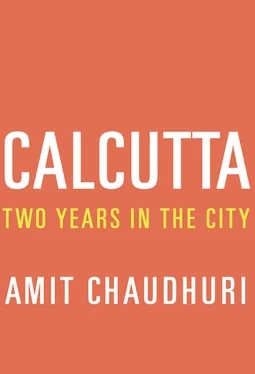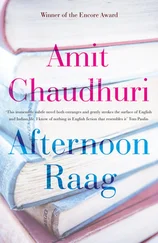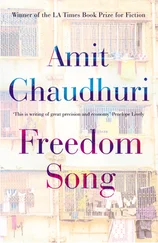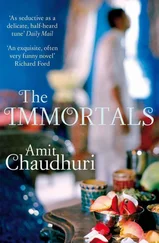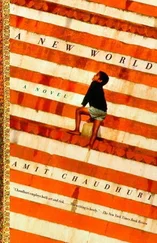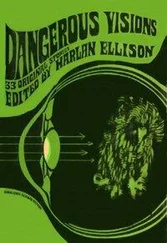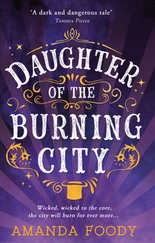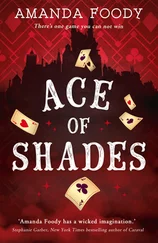I spent most of that evening in Casa Toscana recovering from the impact of Casa Toscana. The main subject — maybe the only subject — of conversation, comparison, and analysis at our table was the restaurant itself. Both from the point of view of Alex and Max, visitors, and my wife and myself, natives, it represented an evolution impossible to anticipate. Archaeologists might discuss and describe the site they’re visiting, but that kind of behaviour isn’t common to diners. Writers, yes, will sometimes feel they’ve found a subject, and begin to talk about it nonchalantly in its very presence. Alex scribbled notes about the music (“well-known over-the-top dramatic opera track”); Max pointed out the light bulbs overhead had been displayed to echo MOMA — all our knowledge and half-baked memories were summoned to consciousness and brought to bear upon our observations. Of course, we commented on the food the moment we ate it — not as food critics would, but as those who, with a faraway look, were condemned to deciphering a national and local mood. “Yes, the spicy arrabiata is good”—conceded Alex. In fact — disappointingly, on one level; thankfully, on another — the food was mostly good. The famous, reclusive Italian chef — where was he? It was a melodramatic, sordid story. The chef — a genuine Michelin-star cook — was well departed; he’d lasted four days. I knew marriages, in a strange bid for immortality, could be perilously terminated in this way; but employment? Saket found a few minutes in his hurried, breathless round to tell us a story that was becoming trite — that this chef’s patience had been worn thin by customers. A source later told me that Saket’s financial terms had caused the breakdown in relations and the sudden exit from Casa Toscana; but why not have those terms clearly agreed to before arriving in Calcutta? It sounded mysterious, but exemplary. Alex and I turned subtly to observe the other diners — not critically, but gripped by the spirit of discovery. “Look,” we nudged one another, glancing unobtrusively but comprehensively, “they’re sharing the pasta.” I saw a waiter portion out a plate of pasta to a small family. There was an unshakeable and overriding Indian-ness to the operation; I thought again of the Italian chef who’d waited, and waited, and, on the fourth day, made his escape.

East European women may well have been introduced to Calcutta by Shah Rukh Khan and the Indian Premiere League. For those who are still unaware of the Indian Premiere League or IPL, it was the “brainchild” (the Indian media’s favoured word) of the youthful, dubious, but until then unproven and little-known tycoon Lalit Modi: a cricketing extravaganza in twenty-over cricket in which celebrated and up-and-coming and even unheard-of players were auctioned to newly created cricketing enterprises. These enterprises — or “teams,” as they’re popularly known — are each named after an Indian city or state, but not yet — as with the Harlem Globetrotters — a neighbourhood. Modi has now lost the franchise he created, equally for his shady dealings and his brashness; but he did persuade some of India’s most ubiquitous and well-worn industrialists and film stars to invest in the teams.
Calcutta’s team — which, at the moment, has no one from Calcutta in it — is called, in the allusive, comic-book style of most of the team names, Kolkata Knight Riders. Its chief owner is the solitary figure atop Bollywood’s pinnacle, the actor Shah Rukh Khan, who has no history of involvement with Calcutta. One of Modi’s many innovations was creating teams that would give voice to the voluble partisanship of a place without necessarily having anything to do with the place itself; another was to import cheerleaders, shaking their hips, fluttering, peacock-like, their pom-poms, fitfully electrified, and electrifying others, each time a run was scored. The cheerleaders were met with grave reproach by both cricket purists and common-or-garden puritans, and then — as is the case with so much in Indian public life — lazily accepted and secretly looked forward to. This was how East European women began to reach, in small contingents, the cities — and Calcutta, in the wake of the Kolkata Knight Riders. There was a time when fans lurked in hotel lobbies in wait of players; now there was a strange transcontinental entourage to stare at.
Shah Rukh Khan became famous for the post-match parties he threw at the ITC Sonar Bangla for the team, cheerleaders, and a handful of unspecified others: models, businessmen, actors, motley KKR well-wishers. These parties, it was told, went on into the morning’s small hours; reportedly, Khan was at them himself. By the accounts of astonished hotel staff, he bounced back early the next day, or went off to catch a flight to Bombay, without any perceived need or desire for sleep. It soon became clear to me that Khan’s mysterious staying powers in Hindi cinema had less to do with his talents than with his youthfulness and inability to become fatigued. On the Eden Gardens ground, during a match, he was almost always on edge, like a coiled spring, pumping the air to cheer his team, deflated very briefly when the innings reached a bad end, then running down and spryly annexing the field. Hearing of the Sonar Bangla parties, I thought for some reason of Gatsby, and the questions that character raised. Not that Khan’s origins — unlike Fitzgerald’s character’s — were an invention; although he’d once issued a Fitzgeraldian caveat, implying that he was, in some sense, unknown to himself: “I am an agent for an actor called Shah Rukh Khan.” No, what brought Gatsby to mind were Khan’s parties, and his freedom from ordinary bodily demands before he took the early morning flight out. This is exactly what startles Nick Carraway when, exhausted, he thanks his host before leaving his party at dawn: “ ‘Don’t give it another thought, old sport.’ The familiar expression held no more familiarity than the hand which reassuringly brushed my shoulder. ‘And don’t forget we’re going up in the hydroplane tomorrow morning, at nine o’clock.’ ” Where the terrific energy of the free market and its players comes from has long troubled those who’ve viewed it from the sidelines.
* * *
Two months after Casa Toscana, I sought out David Canazi, whom I’d never entirely forgotten since chef Sujan Mukherjee mentioned him as the man who’d set up the Italian restaurant in the Hyatt, then married and settled in Calcutta. It was years since the Hyatt had come up on the EM Bypass; and Canazi was now, after the decade closed, evidently introducing Italian food to diners at the coffee shop in Hotel Hindustan International — once, long ago, Calcutta’s best-known hotel after the Grand (albeit a very distant number two), and today well known for having once been Calcutta’s best-known hotel after the Grand. The bourgeoisie and the rich in Calcutta — unlike their counterparts in, say, New Delhi — don’t socialise in five-star hotels; which might be why it was after three decades that I stepped into HHI, asking for directions to the coffee shop.
Mukherjee had informed me that Canazi was a pioneer, one of the first to propagate “authentic” Italian food in these parts; but he’d escaped my attention. I wanted to confront this pioneer face to face; I was also interested in his metamorphosis into a bona fide resident. The others had moved, vanished, or fled; Canazi had not only married, set up shop, but, as it turned out, engendered a family. Meeting him was probably the closest I’d come to interacting with a “white Mughal,” eighteenth-century Europeans who arrived on these shores and were eventually assimilated—“assimilated but unconverted,” perhaps, as Isabel Archer was in her brief, adoptive English life in Portrait of a Lady , but nevertheless taking on family, manners, customs, language, and dress. What would it have been like to make their acquaintance, before the whole business of being Indian, or European, or Bengali, or English, became watertight? Even the Orientalist William Jones, hardly a white Mughal, was known to wear local clothes made of muslin in the heat. Canazi, however, when he emerged from the kitchen after fifteen minutes, was shielded by his apron.
Читать дальше
